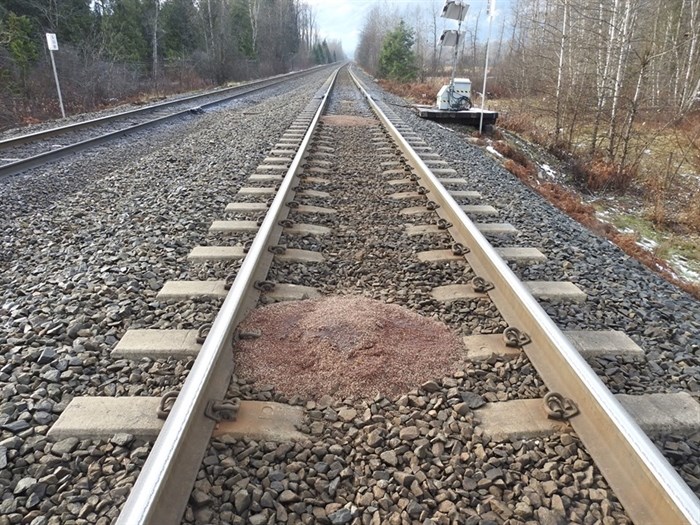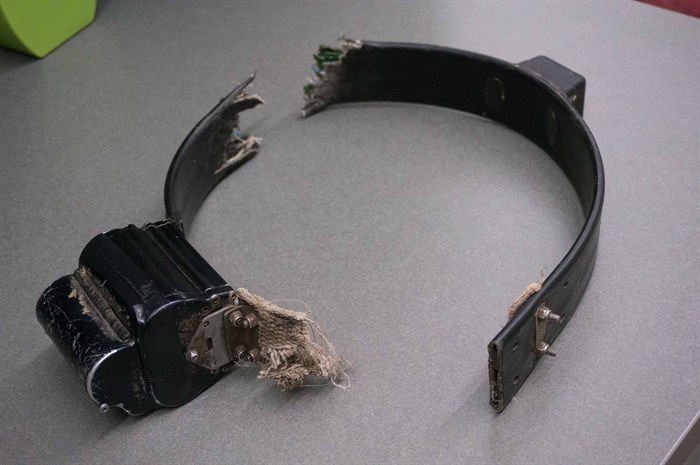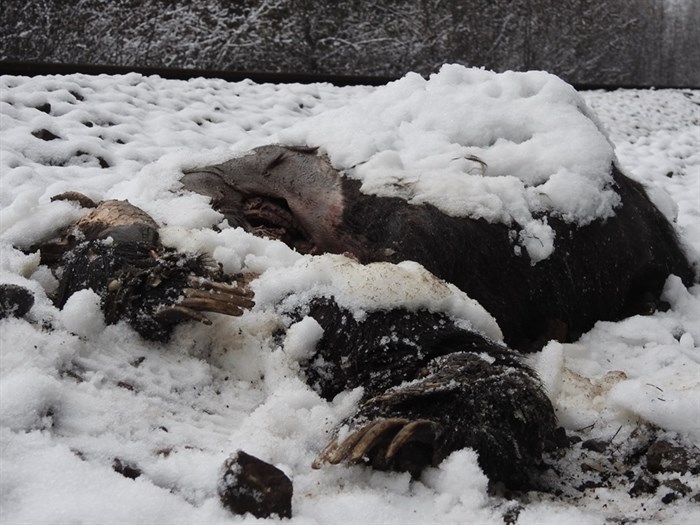
Near the grizzly carcass grain was found on the tracks.
Image Credit: Peter Rowbottom
November 07, 2019 - 7:00 AM
CONTENT ADVISORY
While most people may find it a little unnerving having grizzly bears wander through their yards each day, Malakwa resident Peter Rowbottom got used to the daily presence of a mother and three cubs cutting through his property.
"Then one day they didn't show up... and then they didn't show up for another day and another day," Rowbottom said. "I thought, I wonder what happened (to them)?"
A tip from someone working on the railway led Rowbottom to wander down to the railway tracks near his home in search of the grizzlies. Several visits and five kilometres later, Rowbottom discovered the bears' fate.
It looked like they had been hit by a train.
"It was kind of shocking," he said on discovering the body of a grizzly bear laying in the snow on the side of the tracks. "They were just demolished... the mother didn't even have a head on her."
Recounting the incident that took place last fall, Rowbottom said he found a cub's leg nearby but no other remains of the cubs' bodies.
"I never really thought that they got killed that way."

The impact of a train collision that killed a grizzly bear also broke its GPS collar in two.
Image Credit: Clayton Lamb
According to the B.C. Conservation Foundation more than 24,400 animals are killed by collisions with vehicles each year. As well as the loss of wildlife, around 650 people are injured in wildlife-vehicle collisions each year and three people are killed.
While statistics for vehicle collisions are relatively easy to find, obtaining a number for the amount of wildlife killed by trains across the province is no easy feat.
According to the Ministry of Forest, Lands, Natural Resource Operations and Rural Development, 43 grizzly bears have been killed on railroads since 1982. However, the province openly admits the number is probably a fraction of the actual number due to unreported and unknown deaths.
While Canadian Pacific Railway confirmed it reported all known wildlife mortalities in the province as required under the B.C. Wildlife Act, the company didn't reply when asked for numbers for the last few years.
Canadian National Railway said wildlife collisions with trains were a rare occurrence in the Thompson-Okanagan area, although it did occasionally occur and collisions with bears were even more infrequent. The company said it was unable to provide any data but it continued to work with the province regarding wildlife collisions.
Federal statistics are no easier to find either.
Transport Canada said the Transportation Safety Board of Canada was the place to go for statistics and although the Safety Board volunteered to look, it couldn't confirm whether any statistics were available.
However, grizzly bears being killed by trains is a reality.

A severed bear's foot is pictured following a collision with a train in this submitted photo.
Image Credit: Clayton Lamb
According to a 2019 research paper titled Animal learning may contribute to both problems and solutions for wildlife – train collisions, train strikes have become a leading cause of grizzly bear mortality in Banff National Park.
UBC Okanagan Postdoctoral Fellow Clayton Lamb is involved in on-going research investigating grizzly bear mortalities.
"One of the big problems with the provincial data... is a number of them are not reported or the bears are hit and then die quite a way off the track," Lamb said.
"We do see these animals getting struck by trains and cars and then they end up running somewhere... if they don't die right on the transportation corridor they don't get noticed," he said. "Some go up to a kilometre (away) and then die."
He used GPS collars to track grizzlies in the Elk Valley and Lamb said while he recorded three of the four grizzly bears were killed, only one was reported to the province.
"That's the big issue with the stats, they could be anywhere from double to triple the number," Lamb said. "Estimates from the province are a bare minimum."
And it appears the reason bears are killed by trains is not just poor timing when crossing the tracks.
When Rowbottom discovered his neighbourhood grizzlies dead by the railway he also noticed large piles of grain on the tracks.
According to the B.C. Conservation Foundation, the issue of grain falling from rail cars onto the tracks and then attracting bears and other wildlife, often with deadly consequences, is a significant one.
"The evidence suggests that grizzly bear mortality near rail lines is related to the amount of spilt grain along the rail line," Conservation Foundation coordinator Gayle Hesse said.
To add to this, moose, deer, elk and a variety of other animals are all attracted to grain spilt on train tracks and can often meet a gruesome death if they don't get out of the way of a train in time. Their carcasses are then in turn another major attractant for grizzlies which could then suffer the same fate.
However, Lamb said even on lines where trains don't carry grain, wildlife fatalities are still a problem.
"I think for all wildlife species trains, collisions are a measurable portion of there mortalities especially in transportation corridors," he said.
The ministry keeps data for grizzly bear deaths because compulsory inspections of carcasses for known human-caused deaths are mandatory but other animals simply don't get recorded.
Lamb said simply by volume, deer and elk and moose suffer larger train-related mortality rates than grizzly bears.
With moose populations declining by about 70 per cent in Northern B.C., Hesse said the issue can not be ignored.
While the realities of grizzly bear and other animal railway-related deaths make for sober reading, research is underway to mitigate the issue in some places.
According to the province, ongoing research is taking place with CN Rail and stakeholder groups to mitigate moose-train collisions on rail lines that pass through Prince George in Northern B.C. And in Banff National Park, research has taken place looking at methods to mitigate grizzly bear deaths.
However, Hesse said more needs to be done and wildlife being killed would not be considered a normal part of any industry's operation.
"The rail companies have a tremendous impact on our landscape and on our resources and (their) normal operations should not result in the death of wildlife if it can be prevented," she said.
While Rowbottom saw the sad demise of his visiting bears last fall, he hopes the dozen or so other grizzly bears that pass through his property daily don't meet a similar fate.

The remains of a grizzly bear found near the train tracks in Malakwa in the fall of 2018.
Image Credit: Peter Rowbottom
To contact a reporter for this story, email Ben Bulmer or call (250) 309-5230 or email the editor. You can also submit photos, videos or news tips to the newsroom and be entered to win a monthly prize draw.
We welcome your comments and opinions on our stories but play nice. We won't censor or delete comments unless they contain off-topic statements or links, unnecessary vulgarity, false facts, spam or obviously fake profiles. If you have any concerns about what you see in comments, email the editor in the link above.
News from © iNFOnews, 2019